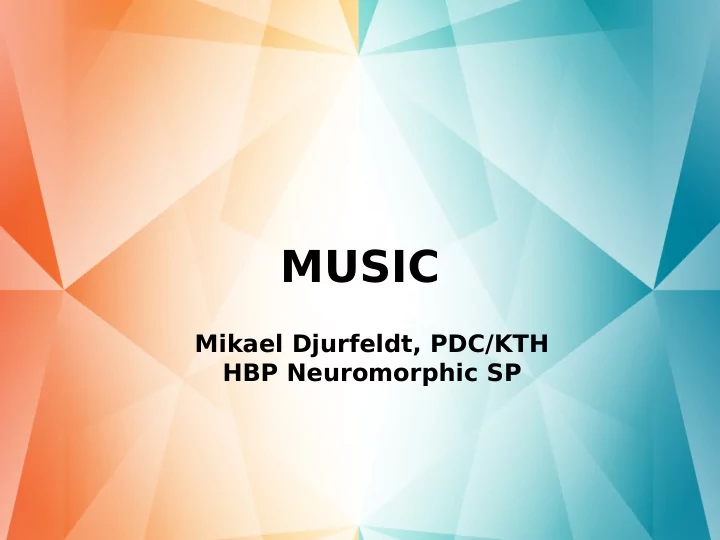

MUSIC Mikael Djurfeldt, PDC/KTH HBP Neuromorphic SP
Outline ● Interfaces in computatjonal neuroscience sofuware ● What is MUSIC? ● Two problems solved by MUSIC: ● spatjal aliasing problem ● temporal aliasing problem ● How to use MUSIC from C++, Python and PyNN ● Use cases ● Where to get sofuware and documentatjon
Interfaces in computational neuroscience Simulatjon environments in computatjonal neuroscience, ● such as NEURON, NEST or Brian, each provide many tools needed by the user to carry out high-quality simulatjon studies. Models described difgerently, ● environments have specifjc features => hard to move models Diffjcult to build larger simulatjons which re-use existjng models ●
Interfaces in computational neuroscience As systems grow and encompass more subsystems, they rapidly ● become unwieldy to develop In general, sofuware in computatjonal neuroscience tends to have ● a monolithic structure Sofuware interfaces (APIs) allow for use of difgerent implementatjons ● of sofuware components MUSIC is an API, and implementatjon in the form of a C++ library, ● supportjng fmowing of data between tools during simulatjon (INCF initjatjve, originally developed by Ö. Ekeberg and M. Djurfeldt)
MUSIC co-simulations A co-simulatjon with multjple parallel applicatjons (A, B, C) exchanging runtjme data (such as neuronal events) Shipping data around between applicatjons during simulatjon useful e.g. for: • Building larger models by combining models as components • Modeling multjple scales and/or combining difgerent formalisms simultaneously • Pre/postprocessing and visualizatjon • Interfacing to external hardware
Network simulation
Using MUSIC to expose data
Co-simulation
Loop
Spatial aliasing problem
Spatial aliasing
Scheduling of communication Handling of tjme in MUSIC • An applicatjon calls MUSIC tick() at points regularly spaced in simulated tjme • This is where data may be sent and/or received • Difgerent applicatjons are allowed to call tick() at difgerent rates • MUSIC may allow applicatjons to run out-of-sync (each with its own ofgset between simulatjon tjme and wallclock tjme) • MUSIC allows complex topology of port connectjvity Scheduling problem • How to deliver data in tjme while avoiding deadlocks • How to interpolate contjnuous data given difgerent tjck rates
Interfaces to MUSIC
C++ app: eventsource
C++ app: eventsource
C++ app: eventlogger
MUSIC configuration file
Interfaces to MUSIC
Python app: eventsource
Interfaces to MUSIC
Usage scenarios
Integrated simulation of the whole-body musculo- skeletal-nervous system for clarifjcation of motor dysfunctions due to neurological diseases Jun Igarashi ¹ , Jan Moren¹, Osamu Shouno³, Kazuya Shimizu², Naoto Yamamura², Junichiro Yoshimoto¹ Shu Takagi² & Kenji Doya¹ 1: Okiniwa Insitutiute of Science and Technology (OIST) 2: Tokyo University 3: Honda research Institute Japan
● Full size, neuron count of rat BG and motor cortex. (~3.2 million neurons) ● Conductance-based IaF or Izhikevich-type neuron models, static or STDP synapses. ● PyNEST and SLI models, connected with MUSIC ● dDIMS: Volumetric FEM-based fluid- mechanical muscle model, full skeletal physics model
MUSIC organization Sample patches/columns on each surface: ● L5BCS → Striatum: 50×50 patches ● L5BPT → Spinal cord: 20x20 patches ● Gpi/EP → Thalamus TC/HT: 1 neuron per channel (3100 total) ● spinal cord → muscle: 1 motor neuron per channel (~750/biceps, 1500/triceps)
preliminary results ● Up: GPe, STN and GPi neurons oscillating at about 14.7Hz. ● Left: power spectrum of GPi, Thalamic CT neurons and L5B PT neurons.
Other highlighted use cases ● Bluebrain Monsteer Library for interactjve visualizatjon ● MUSIC-ROS toolchain Philipp Weidel Thursday 10:10
Where to get MUSIC Github INCF/MUSIC ● MUSIC manual in the distributjon ● Djurfeldt et al. (2010) “Run-tjme interoperability between ● neuronal network simulators based on the MUSIC framework” Neuroinform.
Thanks ● Ekaterina Brocke, SciLife lab, KI – communicatjon algorithms ● Alexander Peyser, Simlab neurosci, FZJ – Python interface ● Andrew Davison, Jochen Eppler and Eilif Muller – PyNN interface ● Rajalekshmi Deepu, Simlab neurosci, FZJ – Travis integratjon ● Jan Morén, OIST – MUSIC applicatjon example ● INCF ● HBP ● Simlab neuroscience ● INM6, FZ Juelich
Recommend
More recommend